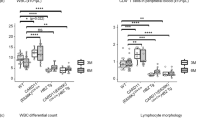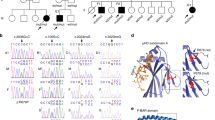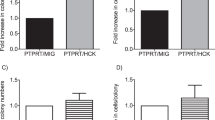Abstract
Mutations in the DYNAMIN2 (DNM2) gene are frequently detected in human acute T-cell lymphoblastic leukemia (T-ALL), although the mechanisms linking these mutations to disease pathogenesis remain unknown. Using an ENU-based forward genetic screen for mice with erythroid phenotypes, we identified a heterozygous mouse line carrying a mutation in the GTPase domain of Dnm2 (Dnm2V265G) that induced a microcytic anemia. In vitro assays using the V265G mutant demonstrated loss of GTPase activity and impaired endocytosis that was comparable to other DNM2 mutants identified in human T-ALL. To determine the effects of DNM2 mutations in T-ALL, we bred the Dnm2V265G mice with the Lmo2 transgenic mouse model of T-ALL. Heterozygous Dnm2 mutants lacking the Lmo2 transgene displayed normal T-cell development, and did not develop T-ALL. In contrast, compound heterozygotes displayed an accelerated onset of T-ALL compared with mice carrying the Lmo2 oncogene alone. The leukemias from these mice exhibited a more immature immunophenotype and an expansion in leukemic stem cell numbers. Mechanistically, the Dnm2 mutation impaired clathrin-mediated endocytosis of the interleukin (IL)-7 receptor resulting in increased receptor density on the surface of leukemic stem cells. These findings suggest that DNM2 mutations cooperate with T-cell oncogenes by enhancing IL-7 signalling.
This is a preview of subscription content, access via your institution
Access options
Subscribe to this journal
Receive 12 print issues and online access
$259.00 per year
only $21.58 per issue
Buy this article
- Purchase on Springer Link
- Instant access to full article PDF
Prices may be subject to local taxes which are calculated during checkout





Similar content being viewed by others
References
Coustan-Smith E, Mullighan CG, Onciu M, Behm FG, Raimondi SC, Pei D et al. Early T-cell precursor leukaemia: a subtype of very high-risk acute lymphoblastic leukaemia. Lancet Oncol 2009; 10: 147–156.
Van Vlierberghe P, Ambesi-Impiombato A, De Keersmaecker K, Hadler M, Paietta E, Tallman MS et al. Prognostic relevance of integrated genetic profiling in adult T-cell acute lymphoblastic leukemia. Blood 2013; 122: 74–82.
Rothenberg EV, Moore JE, Yui MA . Launching the T-cell-lineage developmental programme. Nat Rev Immunol 2008; 8: 9–21.
Zhang J, Ding L, Holmfeldt L, Wu G, Heatley SL, Payne-Turner D et al. The genetic basis of early T-cell precursor acute lymphoblastic leukaemia. Nature 2012; 481: 157–163.
Neumann M, Heesch S, Schlee C, Schwartz S, Gokbuget N, Hoelzer D et al. Whole-exome sequencing in adult ETP-ALL reveals a high rate of DNMT3A mutations. Blood 2013; 121: 4749–4752.
Durieux AC, Prudhon B, Guicheney P, Bitoun M . Dynamin 2 and human diseases. J Mol Med (Berl) 2010; 88: 339–350.
Koutsopoulos OS, Kretz C, Weller CM, Roux A, Mojzisova H, Bohm J et al. Dynamin 2 homozygous mutation in humans with a lethal congenital syndrome. Eur J Hum Genet 2013; 21: 637–642.
Faelber K, Posor Y, Gao S, Held M, Roske Y, Schulze D et al. Crystal structure of nucleotide-free dynamin. Nature 2011; 477: 556–560.
Sorkin A, von Zastrow M . Endocytosis and signalling: intertwining molecular networks. Nat Rev Mol Cell Biol 2009; 10: 609–622.
Luwor RB, Chin X, McGeachie AB, Robinson PJ, Zhu HJ . Dynamin II function is required for EGF-mediated Stat3 activation but not Erk1/2 phosphorylation. Growth Factors 2012; 30: 220–229.
Meloty-Kapella L, Shergill B, Kuon J, Botvinick E, Weinmaster G . Notch ligand endocytosis generates mechanical pulling force dependent on dynamin, epsins, and actin. Dev Cell 2012; 22: 1299–1312.
Nichols JT, Miyamoto A, Olsen SL, D'Souza B, Yao C, Weinmaster G . DSL ligand endocytosis physically dissociates Notch1 heterodimers before activating proteolysis can occur. J Cell Biol 2007; 176: 445–458.
Henriques CM, Rino J, Nibbs RJ, Graham GJ, Barata JT . IL-7 induces rapid clathrin-mediated internalization and JAK3-dependent degradation of IL-7Ralpha in T cells. Blood 2010; 115: 3269–3277.
Ferrando AA, Neuberg DS, Staunton J, Loh ML, Huard C, Raimondi SC et al. Gene expression signatures define novel oncogenic pathways in T cell acute lymphoblastic leukemia. Cancer Cell 2002; 1: 75–87.
Soulier J, Clappier E, Cayuela JM, Regnault A, Garcia-Peydro M, Dombret H et al. HOXA genes are included in genetic and biologic networks defining human acute T-cell leukemia (T-ALL). Blood 2005; 106: 274–286.
Van Vlierberghe P, van Grotel M, Beverloo HB, Lee C, Helgason T, Buijs-Gladdines J et al. The cryptic chromosomal deletion del(11)(p12p13) as a new activation mechanism of LMO2 in pediatric T-cell acute lymphoblastic leukemia. Blood 2006; 108: 3520–3529.
Van Vlierberghe P, Beverloo HB, Buijs-Gladdines J, van Wering ER, Horstmann M, Pieters R et al. Monoallelic or biallelic LMO2 expression in relation to the LMO2 rearrangement status in pediatric T-cell acute lymphoblastic leukemia. Leukemia 2008; 22: 1434–1437.
Homminga I, Pieters R, Langerak AW, de Rooi JJ, Stubbs A, Verstegen M et al. Integrated transcript and genome analyses reveal NKX2-1 and MEF2C as potential oncogenes in T cell acute lymphoblastic leukemia. Cancer Cell 2011; 19: 484–497.
Homminga I, Vuerhard MJ, Langerak AW, Buijs-Gladdines J, Pieters R, Meijerink JP . Characterization of a pediatric T-cell acute lymphoblastic leukemia patient with simultaneous LYL1 and LMO2 rearrangements. Haematologica 2012; 97: 258–261.
Tremblay M, Tremblay CS, Herblot S, Aplan PD, Hebert J, Perreault C et al. Modeling T-cell acute lymphoblastic leukemia induced by the SCL and LMO1 oncogenes. Genes Dev 2010; 24: 1093–1105.
Smith S, Tripathi R, Goodings C, Cleveland S, Mathias E, Hardaway JA et al. LIM domain only-2 (LMO2) induces T-cell leukemia by two distinct pathways. PLoS One 2014; 9: e85883.
Larson RC, Fisch P, Larson TA, Lavenir I, Langford T, King G et al. T cell tumours of disparate phenotype in mice transgenic for Rbtn-2. Oncogene 1994; 9: 3675–3681.
McCormack MP, Young LF, Vasudevan S, de Graaf CA, Codrington R, Rabbitts TH et al. The Lmo2 oncogene initiates leukemia in mice by inducing thymocyte self-renewal. Science 2010; 327: 879–883.
Szilvassy SJ, Humphries RK, Lansdorp PM, Eaves AC, Eaves CJ . Quantitative assay for totipotent reconstituting hematopoietic stem cells by a competitive repopulation strategy. Proc Natl Acad Sci USA 1990; 87: 8736–8740.
Herblot S, Steff AM, Hugo P, Aplan PD, Hoang T . SCL and LMO1 alter thymocyte differentiation: inhibition of E2A-HEB function and pre-T alpha chain expression. Nat Immunol 2000; 1: 138–144.
Neumann M, Vosberg S, Schlee C, Heesch S, Schwartz S, Gokbuget N et al. Mutational spectrum of adult T-ALL. Oncotarget 2015; 6: 2754–2766.
Rank G, Sutton R, Marshall V, Lundie RJ, Caddy J, Romeo T et al. Novel roles for erythroid Ankyrin-1 revealed through an ENU-induced null mouse mutant. Blood 2009; 113: 3352–3362.
Ferguson SM, Raimondi A, Paradise S, Shen H, Mesaki K, Ferguson et al. Coordinated actions of actin and BAR proteins upstream of dynamin at endocytic clathrin-coated pits. Dev Cell 2009; 17: 811–822.
Damke H, Baba T, Warnock DE, Schmid SL . Induction of mutant dynamin specifically blocks endocytic coated vesicle formation. J Cell Biol 1994; 127: 915–934.
Cleveland SM, Smith S, Tripathi R, Mathias EM, Goodings C, Elliott N et al. Lmo2 induces hematopoietic stem cell-like features in T-cell progenitor cells prior to leukemia. Stem Cells 2013; 31: 882–894.
Gerby B, Tremblay CS, Tremblay M, Rojas-Sutterlin S, Herblot S, Hebert J et al. SCL, LMO1 and Notch1 reprogram thymocytes into self-renewing cells. PLoS Genet 2014; 10: e1004768.
Teague TK, Tan C, Marino JH, Davis BK, Taylor AA, Huey RW et al. CD28 expression redefines thymocyte development during the pre-T to DP transition. Int Immunol 2010; 22: 387–397.
Hill TA, Gordon CP, McGeachie AB, Venn-Brown B, Odell LR, Chau N et al. Inhibition of dynamin mediated endocytosis by the dynoles—synthesis and functional activity of a family of indoles. J Med Chem 2009; 52: 3762–3773.
Robertson MJ, Deane FM, Robinson PJ, McCluskey A . Synthesis of Dynole 34-2, Dynole 2-24 and Dyngo 4a for investigating dynamin GTPase. Nat Protoc 2014; 9: 851–870.
Baba T, Damke H, Hinshaw JE, Ikeda K, Schmid SL, Warnock DE . Role of dynamin in clathrin-coated vesicle formation. Cold Spring Harbor Symp Quant Biol 1995; 60: 235–242.
Sever S, Damke H, Schmid SL . Dynamin:GTP controls the formation of constricted coated pits, the rate limiting step in clathrin-mediated endocytosis. J Cell Biol 2000; 150: 1137–1148.
Damke H, Binns DD, Ueda H, Schmid SL, Baba T . Dynamin GTPase domain mutants block endocytic vesicle formation at morphologically distinct stages. Mol Biol Cell 2001; 12: 2578–2589.
Ramachandran R, Surka M, Chappie JS, Fowler DM, Foss TR, Song BD et al. The dynamin middle domain is critical for tetramerization and higher-order self-assembly. EMBO J 2007; 26: 559–566.
Van de Wiele CJ, Marino JH, Tan C, Kneale HA, Weber J, Morelli JN et al. Impaired thymopoiesis in interleukin-7 receptor transgenic mice is not corrected by Bcl-2. Cell Immunol 2007; 250: 31–39.
Silva A, Laranjeira AB, Martins LR, Cardoso BA, Demengeot J, Yunes JA et al. IL-7 contributes to the progression of human T-cell acute lymphoblastic leukemias. Cancer Res 2011; 71: 4780–4789.
Bender M, Giannini S, Grozovsky R, Jonsson T, Christensen H, Pluthero FG et al. Dynamin 2-dependent endocytosis is required for normal megakaryocyte development in mice. Blood 2015; 125: 1014–1024.
Acknowledgements
We thank Geza Paukovics, Jeanne LeMasurier and Phil Donaldson from the AMREP Flow Cytometry Facility for assistance with flow cytometry. We also thank Stephen Cody and Iśka Carmichael from the Monash Micro Imaging platform, as well as Shilpa Bereeka, Loretta Cerruti, Thomas Fulford and Nhu-Y Nguyen for technical assistance. This work was supported by a Project Grant (1052313, MPM and DJC) from the Australian National Health and Medical Research Council (NHMRC), a Research Fellowship (#700153) from The Terry Fox Foundation (CST) and a Senior Medical Research Fellowship from the Sylvia and Charles Viertel Foundation (DJC).
Author contributions
CST and DJC designed research, analyzed data and wrote the manuscript; CST, FCB, JS, MC, SEL, SES and SKC performed research and analyzed data; MLT provided reagents; RA and MPM provided biological samples; PJR and SMJ provided reagents and designed research.
Author information
Authors and Affiliations
Corresponding author
Ethics declarations
Competing interests
The authors declare no conflict of interest.
Additional information
Supplementary Information accompanies this paper on the Leukemia website
Rights and permissions
About this article
Cite this article
Tremblay, C., Brown, F., Collett, M. et al. Loss-of-function mutations of Dynamin 2 promote T-ALL by enhancing IL-7 signalling. Leukemia 30, 1993–2001 (2016). https://doi.org/10.1038/leu.2016.100
Received:
Revised:
Accepted:
Published:
Issue Date:
DOI: https://doi.org/10.1038/leu.2016.100
This article is cited by
-
A review of Dynamin 2 involvement in cancers highlights a promising therapeutic target
Journal of Experimental & Clinical Cancer Research (2021)
-
Small molecule inhibition of Dynamin-dependent endocytosis targets multiple niche signals and impairs leukemia stem cells
Nature Communications (2020)
-
DNA methylation-based classification reveals difference between pediatric T-cell acute lymphoblastic leukemia and normal thymocytes
Leukemia (2020)
-
Adult T-cell acute lymphoblastic leukemias with IL7R pathway mutations are slow-responders who do not benefit from allogeneic stem-cell transplantation
Leukemia (2020)
-
Integrative genomic analyses reveal mechanisms of glucocorticoid resistance in acute lymphoblastic leukemia
Nature Cancer (2020)



